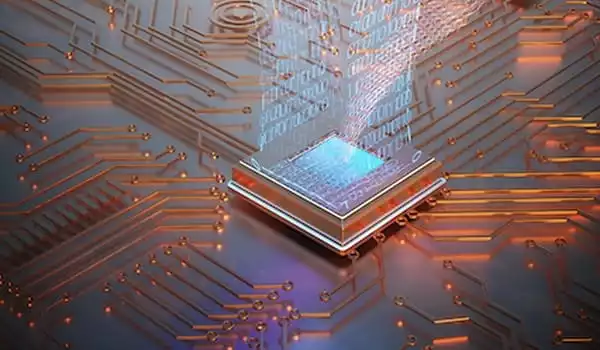Researchers discover predictable behavior in a promising memory material. A team led by Georgia Tech researchers discovered unexpectedly familiar behavior in zirconium dioxide, or zirconia, an anti-ferroelectric material.
In recent years, a class of materials known as anti-ferroelectrics has received a lot of attention for its potential applications in modern computer memory devices. According to research, anti-ferroelectric-based memories may have higher energy efficiency and faster read and write speeds than conventional memories, among other appealing characteristics. Further, the same compounds that can exhibit anti-ferroelectric behavior are already integrated into existing semiconductor chip manufacturing processes.
Now, a team led by Georgia Tech researchers has discovered unexpectedly familiar behavior in zirconium dioxide, or zirconia, an anti-ferroelectric material. They demonstrate that as the material’s microstructure is reduced in size, it behaves similarly to much better understood materials known as ferroelectrics. The findings were published in the journal Advanced Electronic Materials recently.
Anti-ferroelectrics have a range of unique properties like high reliability, high voltage endurance, and broad operating temperatures that make them useful in a wealth of different devices, including high-energy-density capacitors, transducers, and electro-optics circuits.
Nazanin Bassiri-Gharb
Over the last fifty years, circuit miniaturization has played a critical role in improving memory performance. Knowing how the properties of an anti-ferroelectric change as its size decreases should allow for the development of more effective memory components. The researchers also state that the findings should have ramifications in many areas other than memory.
“Anti-ferroelectrics have a range of unique properties like high reliability, high voltage endurance, and broad operating temperatures that make them useful in a wealth of different devices, including high-energy-density capacitors, transducers, and electro-optics circuits,” said Nazanin Bassiri-Gharb, coauthor of the paper and professor at Georgia Tech’s Woodruff School of Mechanical Engineering and the School of Materials Science and Engineering. “However, size scaling effects had largely gone unnoticed for a long time.”
“You can design your device and make it smaller knowing exactly how the material will perform,” said Asif Khan, coauthor of the paper and assistant professor in Georgia Tech’s Schools of Electrical and Computer Engineering and Materials Science and Engineering. “From our perspective, it really opens up a new field of research.”

Lasting Fields
The peculiar way an antiferroelectric material responds to an external electric field is its distinguishing feature. This response combines properties of non-ferroelectric and ferroelectric materials, both of which have received much more attention in physics and materials science.
Exposure to a strong enough external electric field causes ferroelectrics to become strongly polarized, which is a state in which the material exhibits its own internal electric field. This polarization persists even when the external electric field is removed, similar to how an iron nail can become permanently magnetized.
A ferroelectric material’s behavior is also affected by its size. As a material sample becomes thinner, a stronger electric field is required to create permanent polarization, according to a precise and predictable law known as the Janovec-Kay-Dunn (JKD) law.
In contrast, applying an external electric field to an anti-ferroelectric material does not cause it to become polarized at first. However, as the external field strength increases, an anti-ferroelectric material eventually transitions to a ferroelectric phase, where polarization occurs abruptly. The critical field is the electric field required to convert an anti-ferroelectric phase to a ferroelectric phase.
Size Scaling
The researchers discovered that zirconia anti-ferroelectrics also obey something akin to a JKD law in their new study. However, unlike ferroelectrics, the microstructure of the material is important. In the JKD pattern, the critical field strength scales with the size of structures known as crystallites within the material. Even if the sample thickness remains constant, a smaller crystallite size requires a stronger critical field to switch an anti-ferroelectric material into its ferroelectric phase.
“There had not been a predictive law that dictated how the switching voltage will change as these anti-ferroelectric oxide devices were miniaturized,” Khan explained. “We’ve discovered a new spin on an old law.”
Thin anti-ferroelectrics were previously difficult to produce in comparable sizes to ferroelectrics, according to the researchers. According to Khan, Nujhat Tasneem, the doctoral student leading the research, spent “day and night” in the lab processing and producing leakage-free anti-ferroelectric zirconium oxide films of single nanometer size. According to Khan, the next step is for researchers to figure out how to precisely control the crystallite size, thereby tailoring the material’s properties for use in circuits.
The researcher also worked with researchers from the Czech Republic’s Charles University and Chile’s Universidad Andres Bello on X-ray diffraction characterization and first-principles calculations, respectively. “It was truly a collaborative effort that spanned multiple continents,” Tasneem said.
According to Bassiri-Gharb, the findings should shed light on fundamental physics questions. In recent years, the mechanism by which microscopic crystalline structures cause macroscopic polarization has been called into question in the study of antiferroelectrics.
“It’s particularly exciting to discover that two very different types of materials, ferroelectric and anti-ferroelectrics with different atomic structures follow similar behaviors and laws,” said Bassiri-Gharb. “It opens the door to looking for more parallels and transferring more of our knowledge across fields.”





